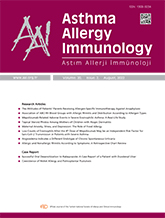


Objective: Symptoms of the patients can guide whether the rhinitis is allergic or non-allergic. Our aim is to identify the prominent symptoms of allergic and non-allergic rhinitis and to evaluate the relationship between the symptoms and disease severity, symptom frequency, and comorbidities.
Materials and Methods: Patients with rhinitis symptoms were retrospectively evaluated in terms of predominant symptoms, symptom severity and persistency and sensitization patterns.
Results: A total of 249 patients with a mean age of 30.7 ± 9.77 (17-64) years were involved in the study. More than half of the patients had allergic rhinitis. Severity of rhinitis was not different between allergic and non-allergic groups but 52.8% of the allergic patients had intermittent and 66.3% of non-allergic patients had persistent symptoms. While postnasal drip was common in non-allergic patients (63.6%), itching, sneezing and eye symptoms were mostly present in allergic rhinitis patients (80.5%, 72.1%, 83.9%, respectively). Patients with postnasal drip and nasal obstruction often had persistent symptoms while patients with itching, sneezing and eye symptoms mostly had intermittent symptoms. Moreover, rhinitis patients with nasal polyposis or chronic rhinosinusitis also had more persistent symptoms. While most of the rhinitis patients with mite allergy (66%) had nasal obstruction, 51.9% of the patients with runny nose, 60.9% of the patients with itchy nose, 65.6% of the subjects with eye symptoms and 54.7% of the patients with sneezing were allergic to pollen.
Conclusion: Sneezing, eye symptoms and itching were the most common symptoms in allergic rhinitis patients while nasal obstruction and postnasal drip were more common in non-allergic rhinitis. In addition, the presence of nasal obstruction and postnasal drip may indicate that the disease is more persistent, more severe, and often accompanied by chronic rhinosinusitis, nasal polyposis, and asthma.